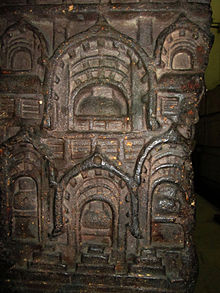Keel bow
A keel arch , also known as a donkey's back , saddle arch , Scottish arch or accolade , in architecture refers to an arch with curved edges that are convex in the lower part and concave in the upper part. The outline of the arch thus resembles a ship's keel turned upside down .
construction
Three-dimensional keel arches usually have an inner and an outer arch; these can be designed uniformly, but in many cases the inner (lower) arch is a round or pointed arch , whereas the outer (upper) arch is designed as a "donkey's back". Overall, a large number of possible variations can be observed.
The centers of the two lower arcs are inside, those of the upper arcs are outside the arcs. If the two lower centers of the circle coincide at one point, a common shape of the keel arch is created; if they are apart, the arch is given a more pressed shape. If, on the other hand, the arch is constructed in such a way that it is a variant of the pointed arch, which has only a small opposite arch at the tip, it is called "donkey back" or "donkey bow"; the name is derived from the donkey's protruding backbone .
history
origin
The keel arch seems to have its origin in India , where as early as the 3rd century BC. Entrances to the Buddhist cave monasteries were inflated in this way. The background to such a design is unclear, but similarities to the similarly sharpened leaves of the Bodhi tree or to a prayer posture with hands raised and clenched above the head, which is widespread in India, are striking; However, it could also be a matter of emphasizing or exaggerating the center in a purely architectural and aesthetic way. In any case, in later times such entrance designs were converted into windows ( kudus ) and even later blind decorative elements ( chandrasalas ) developed from them , which were often combined to form larger decorative panels ( udgamas ).
development
In Islamic architecture, keel arches only came into use around 1100. They experienced their first highlights in Persian and Egyptian architecture, but in the 12th century they also appeared in the Maghreb and Andalusia .
In Central and Northern Europe, keel arches did not come into use until the 13th and 14th centuries - with a few exceptions in book illuminations. In use in the late Gothic era - the earliest examples are commonly considered to be some of the Eleanor crosses in England. Keel arches are particularly often found as the upper end of a portal or window frame, either as appropriately shaped archivolts , window lintels or ornamental gables in the form of roofs or crowns . Accordingly, these structural elements are referred to as "keel arch windows" or "keel arch portals".
Examples
India
Barabar Caves ( Lomas Rishi Cave ),
3rd century BC Chr.Udayagiri and Khandagiri Caves,
approx. 2nd century BC Chr.Udayagiri and Khandagiri Caves ( Ranigumpha )
Vestibule of Bedsa Cave, 1st or 2nd century AD
Islam
Quwwat-ul-Islam Mosque , Delhi, India (around 1225)
Wall niche with Kor claims , Lodi Gardens , Delhi, India (15th century)
Mihrab of the Dilawar Khan Mosque, Mandu , India (15th century)
Jama Masjid , Delhi, India (around 1650)
Europe
On consoles patch ogee arches at the Porte de la Craffe in Nancy , France
Keel arch portal of a church in Dumfries , Scotland
Late Gothic seat niche portal with five-fold keel arch (1506) at the Peter Ulrich House in Pirna
Arched keel window on a house in La Garriga , Spain
Arched keel window at Palazzo Corvaja in Taormina , Italy
literature
- Roswitha Beyer: Eselsücken , in: Reallexikon zur Deutschen Kunstgeschichte , Vol. 6, 1968, Sp. 1–22.
Web links
Individual evidence
- ↑ donkey bow in the universal lexicon, accessed on June 20, 2015
- ↑ Donkey back at Duden Online, accessed on June 20, 2015



















